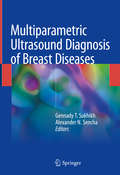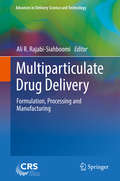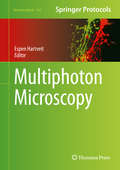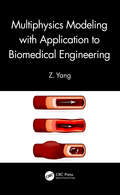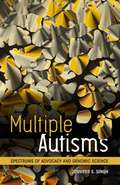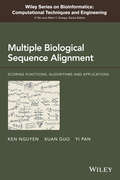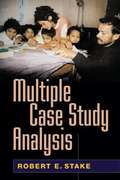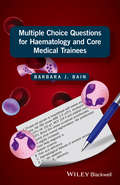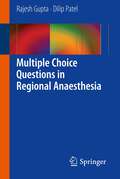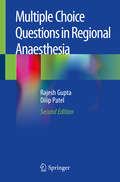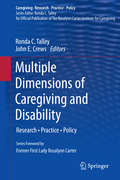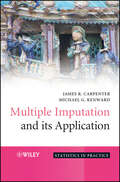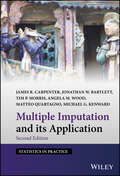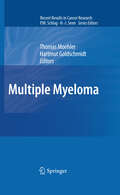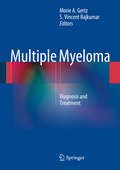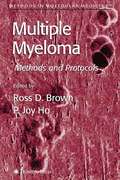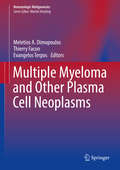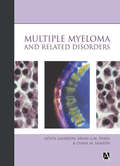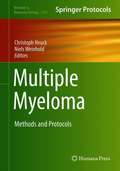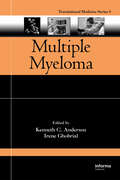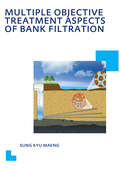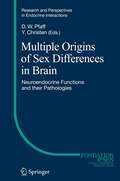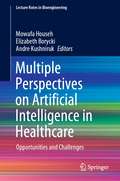- Table View
- List View
Multiparameter Flow Cytometry in the Diagnosis of Hematologic Malignancies
by Anna Porwit Marie-Christine BénéMaster the implementation of flow cytometry techniques in diagnosing complex hematologic diseases and malignancies in patients with this comprehensive and practical guide. Featuring updated recommendations on pre-analytical steps, instrument settings and panel construction, this manual offers invaluable support for those diagnosing, treating and researching hematologic malignancies. Written by leading experts in the field, this book puts flow cytometry into everyday context. Through engaging with differential diagnoses, the manual offers an accurate description of specific features of malignancies and mimicking conditions. It also places flow cytometry in the scope of integrated diagnosis according to WHO and ICC classifications. Fully updated throughout, this second edition provides new literature and concepts, and presents new AI-based analytical methods. Richly illustrated and in full colour, this book is an ideal resource for those working in flow cytometry laboratories.
Multiparametric Ultrasound Diagnosis of Breast Diseases
by Alexander N. Sencha Gennady T. SukhikhThis richly illustrated book provides a comprehensive overview of the use of current ultrasound techniques, including contrast-enhanced ultrasound and ultrasonic elastography, in the diagnosis of breast disease. The advantages and pitfalls of the various imaging modalities are identified, and it is explained how combined use of the modalities – multiparametric ultrasound – aids diagnosis and in particular assists in the differentiation of benign and malignant disease. Readers will find detailed description and illustration of the imaging appearances of age-related features (including in children and adolescents), the most important benign diseases, different forms of breast cancer, mammary gland pathology in the contexts of pregnancy and female reproductive system disease, chest gland pathology in males, and recurrent and metastatic disease. In addition, ultrasound-guided breast interventions and imaging of breast implants are discussed. Specialists in ultrasound diagnostics, radiologists, oncologists, and surgeons will all find this topical book to be both interesting and helpful in daily clinical practice.
Multiparticulate Drug Delivery
by Ali R. Rajabi-SiahboomiAuthored by leading experts from academia, users and manufacturers, this book provides an authoritative account of the science and technology involved in multiparticulate drug delivery systems which offer superior clinical and technical advantages over many other specialized approaches in drug delivery. The book will cover market trends, potential benefits and formulation challenges for various types of multiparticulate systems. Drug solubility, dose, chemistry and therapeutic indications as well as excipient suitability coupled with manufacturing methods will be fully covered. Key approaches for taste-masking, delayed release and extended release of multiparticulates systems are of significant interest, especially their in-vivo and in-vitro performance. In addition, the principles of scale-up, QbD, and regulatory aspects of common materials used in this technology will be explained, as well as recent advances in materials and equipment enabling robust, flexible and cost-effective manufacture. Case studies illustrating best practices will also make the book a valuable resource to pharmaceutical scientists in industry and academia.
Multiphoton Microscopy (Neuromethods #148)
by Espen HartveitThis volume covers the latest techniques and strategies used in multi-photon excitation (MPE) microscopy. Chapters in this book cover the fundamentals of MPE microscopy as applied to both in vitro and in vivo experimental systems; information on how to combine MPE microscopy with targeted electrophysiological recordings, calcium imaging, and transmembrane voltage imaging; methods to investigate cellular and large-scale neural morphology; signaling in astrocytes; and ways to use MPE microscopy to study the retina. In Neuromethods series style, chapters include the kind of detail and key advice from the specialists needed to get successful results in your laboratory.Comprehensive and thorough, Multiphoton Microscopy is a valuable resource for both expert and novice researchers interested in expanding their knowledge and research in this rapidly developing field.
Multiphysics Modeling with Application to Biomedical Engineering
by Z. YangThe aim of this book is to introduce the simulation of various physical fields and their applications for biomedical engineering, which will provide a base for researchers in the biomedical field to conduct further investigation. The entire book is classified into three levels. It starts with the first level, which presents the single physical fields including structural analysis, fluid simulation, thermal analysis, and acoustic modeling. Then, the second level consists of various couplings between two physical fields covering structural thermal coupling, porous media, fluid structural interaction (FSI), and acoustic FSI. The third level focuses on multi-coupling that coupling with more than two physical fields in the model. Each part in all levels is organized as the physical feature, finite element implementation, modeling procedure in ANSYS, and the specific applications for biomedical engineering like the FSI study of Abdominal Aortic Aneurysm (AAA), acoustic wave transmission in the ear, and heat generation of the breast tumor. The book should help for the researchers and graduate students conduct numerical simulation of various biomedical coupling problems. It should also provide all readers with a better understanding of various couplings.
Multiple Autisms: Spectrums of Advocacy and Genomic Science
by Jennifer S. SinghIs there a gene for autism? Despite a billion-dollar, twenty-year effort to find out—and the more elusive the answer, the greater the search seems to become—no single autism gene has been identified. In Multiple Autisms, Jennifer S. Singh sets out to discover how autism emerged as a genetic disorder and how this affects those who study autism and those who live with it. This is the first sustained analysis of the practices, politics, and meaning of autism genetics from a scientific, cultural, and social perspective.In 2004, when Singh began her research, the prevalence of autism was reported as 1 in 150 children. Ten years later, the number had jumped to 1 in 100, with the disorder five times more common in boys than in girls. Meanwhile the diagnosis changed to &“autistic spectrum disorders,&” and investigations began to focus more on genomics than genetics, less on single genes than on hundreds of interacting genes. Multiple Autisms charts this shift and its consequences through nine years of ethnographic observations, analysis of scientific and related literatures, and morethan seventy interviews with autism scientists, parents of children with autism, and people on the autism spectrum. The book maps out the social history of parental activism in autism genetics, the scientific optimism about finding a gene for autism and the subsequent failure, and the cost in personal and social terms of viewing and translating autism through a genomic lens.How is genetic information useful to people living with autism? By considering this question alongside the scientific and social issues that autism research raises, Singh&’s work shows us the true reach and implications of a genomic gaze.
Multiple Biological Sequence Alignment: Scoring Functions, Algorithms and Evaluation
by Yi Pan Ken Nguyen Xuan GuoCovers the fundamentals and techniques of multiple biological sequence alignment and analysis, and shows readers how to choose the appropriate sequence analysis tools for their tasks This book describes the traditional and modern approaches in biological sequence alignment and homology search. This book contains 11 chapters, with Chapter 1 providing basic information on biological sequences. Next, Chapter 2 contains fundamentals in pair-wise sequence alignment, while Chapters 3 and 4 examine popular existing quantitative models and practical clustering techniques that have been used in multiple sequence alignment. Chapter 5 describes, characterizes and relates many multiple sequence alignment models. Chapter 6 describes how traditionally phylogenetic trees have been constructed, and available sequence knowledge bases can be used to improve the accuracy of reconstructing phylogeny trees. Chapter 7 covers the latest methods developed to improve the run-time efficiency of multiple sequence alignment. Next, Chapter 8 covers several popular existing multiple sequence alignment server and services, and Chapter 9 examines several multiple sequence alignment techniques that have been developed to handle short sequences (reads) produced by the Next Generation Sequencing technique (NSG). Chapter 10 describes a Bioinformatics application using multiple sequence alignment of short reads or whole genomes as input. Lastly, Chapter 11 provides a review of RNA and protein secondary structure prediction using the evolution information inferred from multiple sequence alignments. * Covers the full spectrum of the field, from alignment algorithms to scoring methods, practical techniques, and alignment tools and their evaluations * Describes theories and developments of scoring functions and scoring matrices *Examines phylogeny estimation and large-scale homology search Multiple Biological Sequence Alignment: Scoring Functions, Algorithms and Applications is a reference for researchers, engineers, graduate and post-graduate students in bioinformatics, and system biology and molecular biologists. Ken Nguyen, PhD, is an associate professor at Clayton State University, GA, USA. He received his PhD, MSc and BSc degrees in computer science all from Georgia State University. His research interests are in databases, parallel and distribute computing and bioinformatics. He was a Molecular Basis of Disease fellow at Georgia State and is the recipient of the highest graduate honor at Georgia State, the William M. Suttles Graduate Fellowship. Xuan Guo, PhD, is a postdoctoral associate at Oak Ridge National Lab, USA. He received his PhD degree in computer science from Georgia State University in 2015. His research interests are in bioinformatics, machine leaning, and cloud computing. He is an editorial assistant of International Journal of Bioinformatics Research and Applications. Yi Pan, PhD, is a Regents' Professor of Computer Science and an Interim Associate Dean and Chair of Biology at Georgia State University. He received his BE and ME in computer engineering from Tsinghua University in China and his PhD in computer science from the University of Pittsburgh. Dr. Pan's research interests include parallel and distributed computing, optical networks, wireless networks and bioinformatics. He has published more than 180 journal papers with about 60 papers published in various IEEE/ACM journals. He is co-editor along with Albert Y. Zomaya of the Wiley Series in Bioinformatics.
Multiple Blessings: Surviving to Thriving with Twins and Sextuplets
by Jon Gosselin Kate Gosselin Beth CarsonAutobiography of a couple who had twins, and three years, sextuplets. Kate chronicles the emotional and exhausting challenges she and Jon faced from conception of the babies through their first two years of life.
Multiple Case Study Analysis
by Robert E. StakeExamining situational complexity is a vital part of social and behavioral science research. This engaging text provides an effective process for studying multiple cases--such as sets of teachers, staff development sessions, or clinics operating in different locations--within one complex program. The process also can be used to investigate broadly occurring phenomena without programmatic links, such as leadership or sibling rivalry. Readers learn to design, analyze, and report studies that balance common issues across the group of cases with the unique features and context of each case. Three actual case reports from a transnational early childhood program illustrate the author's approach, and helpful reproducible worksheets facilitate multicase recording and analysis.
Multiple Choice Questions for Haematology and Core Medical Trainees
by Barbara J. BainWritten to help haematology and general medical trainees evaluate their own knowledge, and particularly useful for those preparing for the Part 1 examination of the Royal College of Pathologists. This exam-centered book will also be of use to core medical trainees preparing for the examinations of the Royal College of Physicians and the Royal Australasian College of Physicians and to haematology and general medicine trainees in other countries where methods of examination are similar. The 200 questions are presented in two formats, Single Best Answer and Extended Matching Question, and comes complete wih detailed feedback and, when appropriate, relevant references are given for each question so that those who select the wrong answer will understand why another answer is better. Quick reference question book, ideal for examination preparation Includes 50 SBA questions, ideal for the Part 1 and Part 2 MRCP examinations, which although having a general medical slant, are also appropriate for haematology specialist trainees Includes 70 SBA multiple choice questions appropriate for haematology specialist trainees but also useful to core medical trainees Includes 30 EMQs suitable for those taking Part 1 of the FRCPath examination Questions come complete with fully referenced answers and discussion points This book provides an educational tool for training as well as an ideal way to prepare for examinations and is also of value to those know examine of haematology and haematopathology.
Multiple Choice Questions in Regional Anaesthesia
by Rajesh Gupta Dilip PatelInterest in regional anaesthesia has been flourishing for a number of reasons, including in particular the feasibility of ultrasound-guided peripheral nerve blocks. This trend is reflected in the growing popularity of fellowships in regional anaesthesia. The syllabus for such fellowship examinations is vast, and the current book aims to provide suitable guidance by presenting typical multiple choice questions with accompanying answers, in detail when necessary. The entire syllabus is covered in four sections that address basic principles and equipment, peripheral nerve blocks, central neuraxial blocks, and regional anaesthesia and acute pain. This book will be especially useful for those preparing for European Society of Regional Anaesthesia diploma examinations or for the regional anaesthesia component of FRCA examinations. It is also highly relevant to equivalent U.S. and Canadian examinations and will be helpful to all who require a self-assessment tool in the subject.
Multiple Choice Questions in Regional Anaesthesia
by Rajesh Gupta Dilip PatelThis revised and expanded second edition is a learning and self-assessment tool for the study of regional anesthesia. The first part deals with the basic principles of regional anesthesia and the equipment used. This is followed by sections on peripheral nerve blocks, central neuraxial blocks and pain. Pediatric regional anesthesia is discussed along with the adult blocks. There are additional MCQs in each section, and new chapters on the anatomy, physiology, assessment and monitoring of acute pain. This book is aimed at those studying for the European Society of Regional Anesthesia Diploma Examinations, regional anesthesia component of FRCA examinations, and exit examinations for regional anesthesia fellowships. It is also relevant to the regional anesthesia component of US Board examinations and the Canadian fellowships in regional anesthesia.
Multiple Dimensions of Caregiving and Disability
by John E. Crews Ronda C. TalleyCaring for people with disabilities often becomes an all-encompassing responsibility for one or more family members. To manage the multifaceted demands, caregivers must possess strong multitasking skills, including the ability to assist with daily life tasks; provide emotional support; help with financial affairs; mediate and advocate with health care providers. Maintaining balance within their own lives can become incredibly challenging for caregivers. More often than not, providing care for family members or loved ones occurs at the expense of the caregivers' well-being. And for caregivers who themselves have disabilities, it further complicates matters. Multiple Dimensions of Caregiving and Disability addresses concerns that have been long familiar to the caregiver population and examines the current state of family care for individuals with disabilities. With a lifespan perspective, this concise reference reviews the literature on specific problems of caregivers and explores which care strategies are effective, promising, or lacking in available resources and support interventions. Contributors also explore the more fluid and subjective aspects of caregiving, such as feelings, spirituality, and family roles. Suggestions for future policy improvements, particularly within the public health sector, are discussed as well. Topics covered include: * Family dynamics and caregiving for people with disabilities. * Parent caregiving of children with disabilities. * Race, ethnicity, socioeconomic status, and caregiving. * Educational, training, and support programs for caregivers. * Emerging technologies to aid caregivers. * Developing partnerships between caregivers and health care providers. Multiple Dimensions of Caregiving and Disability is a must-have resource for researchers, scientist-practitioners, policy makers, and graduate students across such disciplines as clinical psychology, nursing, social work, public health, medicine, and social and education policy.
Multiple Imputation and its Application
by Michael Kenward James CarpenterA practical guide to analysing partially observed data.Collecting, analysing and drawing inferences from data is central to research in the medical and social sciences. Unfortunately, it is rarely possible to collect all the intended data. The literature on inference from the resulting incomplete data is now huge, and continues to grow both as methods are developed for large and complex data structures, and as increasing computer power and suitable software enable researchers to apply these methods.This book focuses on a particular statistical method for analysing and drawing inferences from incomplete data, called Multiple Imputation (MI). MI is attractive because it is both practical and widely applicable. The authors aim is to clarify the issues raised by missing data, describing the rationale for MI, the relationship between the various imputation models and associated algorithms and its application to increasingly complex data structures.Multiple Imputation and its Application:Discusses the issues raised by the analysis of partially observed data, and the assumptions on which analyses rest.Presents a practical guide to the issues to consider when analysing incomplete data from both observational studies and randomized trials.Provides a detailed discussion of the practical use of MI with real-world examples drawn from medical and social statistics.Explores handling non-linear relationships and interactions with multiple imputation, survival analysis, multilevel multiple imputation, sensitivity analysis via multiple imputation, using non-response weights with multiple imputation and doubly robust multiple imputation.Multiple Imputation and its Application is aimed at quantitative researchers and students in the medical and social sciences with the aim of clarifying the issues raised by the analysis of incomplete data data, outlining the rationale for MI and describing how to consider and address the issues that arise in its application.
Multiple Imputation and its Application (Statistics in Practice)
by James R. Carpenter Michael G. Kenward Jonathan W. Bartlett Tim P. Morris Angela M. Wood Matteo QuartagnoMultiple Imputation and its Application The most up-to-date edition of a bestselling guide to analyzing partially observed data In this comprehensively revised Second Edition of Multiple Imputation and its Application, a team of distinguished statisticians delivers an overview of the issues raised by missing data, the rationale for multiple imputation as a solution, and the practicalities of applying it in a multitude of settings. With an accessible and carefully structured presentation aimed at quantitative researchers, Multiple Imputation and its Application is illustrated with a range of examples and offers key mathematical details. The book includes a wide range of theoretical and computer-based exercises, tested in the classroom, which are especially useful for users of R or Stata. Readers will find: A comprehensive overview of one of the most effective and popular methodologies for dealing with incomplete data sets Careful discussion of key concepts A range of examples illustrating the key ideas Practical advice on using multiple imputation Exercises and examples designed for use in the classroom and/or private study Written for applied researchers looking to use multiple imputation with confidence, and for methods researchers seeking an accessible overview of the topic, Multiple Imputation and its Application will also earn a place in the libraries of graduate students undertaking quantitative analyses.
Multiple Myeloma
by Hartmut Goldschmidt Thomas MoehlerMultiple myeloma is currently still an incurable disease, but during the past decade knowledge of its molecular pathogenesis has increased rapidly. This has led to remarkable progress in both diagnosis and therapy, including in particular the approval of novel and first-in-class drugs such as thalidomide, bortezomib, and lenalidomide. This book, written by internationally acknowledged experts, covers a wide range of topics relating to multiple myeloma, including history, epidemiology, pathophysiology, clinical features, staging, and prognostic systems. The principal focus, however, is on therapy, with detailed information on the various promising treatment options which give hope that this cancer will be transformed into a chronic disease or even become curable. Individualized therapy and the variety of supportive treatment options, as described in this volume, will help in achieving this goal, as well as in reducing adverse events and improving quality of life.
Multiple Myeloma
by Morie A. Gertz S. Vincent RajkumarThis is a comprehensive, state-of-the-art guide to the diagnosis, treatment, and biology of multiple myeloma and related plasma disorders Edited and written by a multidisciplinary group of recognized authorities from the Mayo Clinic, it presents clear guidelines on diagnosis and therapy and covers all aspects of multiple myeloma, from molecular classification and diagnosis, to risk stratification and therapy Closely related plasma cell disorders such as solitary plasmacytoma, Waldenstrom macroglobulinemia, and light chain amyloidosis are discussed in detail as well. The book addresses often overlooked topics, including the role of radiation therapy, vertebral augmentation, and supportive care. Our understanding of this group of disorders is developing at an unprecedented rate, and Multiple Myeloma meets the need among oncologists and hematologists for a clear, timely, and authoritative resource on their biology, diagnosis, and treatment.
Multiple Myeloma
by P. Joy Ho Ross D. BrownA comprehensive collection of classic and innovative methodologies used in many laboratories for the investigation of multiple myeloma. These readily reproducible techniques range from the standard Plasma Cell Labeling Index methodology to a final chapter on making sense of microarrays, and include the full spectrum of cytogenetic and molecular diagnostic methods. The protocols follow the successful Methods in Molecular MedicineTM series format, each offering step-by-step laboratory instructions, an introduction outlining the principle behind the technique, lists of the necessary equipment and reagents, and tips on troubleshooting and avoiding known pitfalls. These proven techniques are ideal for studying the pathogenesis of multiple myeloma and identifying new therapeutic targets.
Multiple Myeloma and Other Plasma Cell Neoplasms (Hematologic Malignancies #0)
by Meletios A. Dimopoulos Thierry Facon Evangelos TerposThis book is a comprehensive source of up-to-date information on plasma cell neoplasms. Key features include the provision of new criteria for the diagnosis of symptomatic multiple myeloma requiring treatment and the description of novel therapies for myeloma and other plasma cell neoplasms that have only very recently been licensed by the U.S. Food and Drug Administration. Examples include lenalidomide as first-line therapy, panobinostat in combination with bortezomib plus dexamethasone for relapsed/refractory myeloma, ibrutinib for Waldenström’s macroglobulinemia, and new therapeutic regimens for systemic amyloidosis and POEMS syndrome. Information is also provided on drug combinations that have shown encouraging results and are very near to approval. Other important aspects covered in the book are the role of different imaging modalities in workup and the significance of newly acquired data relating to prognosis and minimal residual disease. Readers will find Multiple Myeloma and Other Plasma Cell Neoplasms to be a rich source of knowledge that will be invaluable in improving patient management.
Multiple Myeloma and Related Disorders
by Brian Gösta Gahrton Diana M. SamsonDuring the past decade there has been an enormous increase in knowledge of multiple myeloma and related disorders, reflected in the publication of more than 5000 articles on the subject in scientific journals. Much of this has come about as new technologies have made it possible to refine studies on chromosomes and genes and to gain information abo
Multiple Myeloma: Methods And Protocols (Methods in Molecular Biology #1792)
by Christoph Heuck Niels WeinholdThis volume provides a thorough guide of the study of multiple myeloma (MM)—from sample acquisition to the performance of molecular tests, and also discusses difficulties that arise during quality control and interpretation of results. The chapters in this book cover topics, such as next-generation-flow-based methods for detection of minimal residual disease and circulating tumor cells; Cytometry by Time-of-Flights (CyTOF); a droplet digital PCR approach for finding contamination in patients’ samples; genome-wide investigation of the methylation and hydroxymethylation status of cytosines; and a microfluidic approach for creating nanoparticles. Written in the highly successful Methods in Molecular Biology series format, chapters include introductions to their respective topics, lists of the necessary materials and reagents, step-by-step, readily reproducible laboratory protocols, and tips on troubleshooting and avoiding known pitfalls. Cutting-edge and comprehensive, Multiple Myeloma: Methods and Protocols is a valuable resource for molecular scientists and laboratory supervisors working with MM samples, and any investigator conducting studies in this field.
Multiple Myeloma: Translational and Emerging Therapies (Translational Medicine)
by Kenneth C. Anderson Irene M. GhobrialMultiple myeloma is the second most prevalent hematological malignancy, with over 55,000 new cases diagnosed each year. This exciting new text, edited by lauded authorities on the topic, stands as the only available reference to assemble, review, and synthesizes the latest studies on translational therapies and clearly explains the impact of molecular pathogenesis, biology, and prognostic factors on the diagnosis, prognosis, and individualization of treatment and the development of novel therapeutic options for patients with myeloma.
Multiple Objective Treatment Aspects of Bank Filtration: Unesco-ihe Phd Thesis
by Sung Kyu MaengBank filtration (BF) is a natural water treatment process which induces surface water to flow in response to a hydraulic gradient through soil/sediment and into a vertical or horizontal well. It is a relatively cost-effective, robust and sustainable technology. From a historical perspective, BF is first mentioned in the bible, and the process has been recognized as a proven method for drinking water treatment in Europe for more than 100 years. However, the mechanisms of removal of different contaminants during BF are not fully understood. This study showed that BF is an effective multiple objective barrier for removal of different contaminants present in surface water sources including bulk organic matter and organic micropollutants (OMPs) like pharmaceutically active compounds and endocrine disrupting compounds. It was found that biodegradation and adsorption play primary and secondary roles, respectively, in the removal of OMPs during soil passage. Furthermore, using field data from BF sites and chemical properties of OMPs, models were developed to estimate the removal of OMPs during soil passage. It can be concluded that the removal efficiencies of BF for these contaminants can be maximised by proper design and operation of recovery wells taking into consideration source water quality characteristics and local hydrogeological conditions.
Multiple Origins of Sex Differences in Brain
by Yves Christen Donald W PfaffIn theoretical terms, sex differences in brains and behaviors of laboratory animals offer the possibility of fascinating scientific studies on a range of molecular phenomena such as genomic imprinting, DNA methylation, chromatin protein modification, non-coding DNA, potentially resulting in important neuroanatomical and neurochemical sex differences in the brain. Such sex differences could arise consequent to exposures to testosterone early in development, or to other effects deriving from the Y chromosome. However, this general subject has been treated with much hyperbole. Historically, sex differences were assumed to be present where they did not really exist, e.g. with respect to mathematics, executive leadership, etc. etc. Under what circumstances do we really care about sex differences in brain and behavior? These circumstances concern human maladies whose diagnoses are much different between boys and girls, or between women and men. Prominent examples discussed in this volume include autism, attention deficit hyperactivity disorders and congenital adrenal hyperplasia. In fact, infant boys are more susceptible than infant girls to a variety of disorders that arise early in development. This volume then ends with a consideration of effects of estrogenic hormones on the injured brain, and their roles as protective agents.
Multiple Perspectives on Artificial Intelligence in Healthcare: Opportunities and Challenges (Lecture Notes in Bioengineering)
by Mowafa Househ Elizabeth Borycki Andre KushnirukThis book offers a comprehensive yet concise overview of the challenges and opportunities presented by the use of artificial intelligence in healthcare. It does so by approaching the topic from multiple perspectives, e.g. the nursing, consumer, medical practitioner, healthcare manager, and data analyst perspective. It covers human factors research, discusses patient safety issues, and addresses ethical challenges, as well as important policy issues. By reporting on cutting-edge research and hands-on experience, the book offers an insightful reference guide for health information technology professionals, healthcare managers, healthcare practitioners, and patients alike, aiding them in their decision-making processes. It will also benefit students and researchers whose work involves artificial intelligence-related research issues in healthcare.

